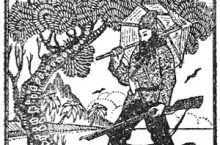“People will absolutely love him,” Hopper said. “I think it’s important to point out that he has an amazing depth of experience.”“There’s a really low barrier to entry and really high skill path,” Hopper said.Historical fencing is a modern combat sport that combines techniques from the 12th century all the way to the 20th century, […]


“People will absolutely love him,” Hopper said. “I think it’s important to point out that he has an amazing depth of experience.”“There’s a really low barrier to entry and really high skill path,” Hopper said.Historical fencing is a modern combat sport that combines techniques from the 12th century all the way to the 20th century, when fencing was already developing into what people recognize as modern fencing.
Boston Armizare classes are for students age 16 and up, and anyone under 18 needs parental permission. Davis thinks historical fencing is different from contemporary fencing. Gaining experience with age can be more important than the athleticism in younger athletes. At 32, Davis doesn’t plan on retiring anytime soon.“Once we start expelling some of the intrinsic qualities of the sword, its weight, the way that you hold it with your arms, and the principles of geometry, I think people catch on pretty quickly,” Hopper said.“It’s kind of a hub to our community where there is programing and activities for kids through seniors.”“You can’t really do it with a modern Olympic sword. They’re too fast, they’re too light. People can kind of whip them around very quickly,” Davis said. “But when the sword weighs like 2 pounds, movements aren’t as snappy and fast. There’s a whole game there of positioning and how you set up placing your sword and all that.”“That just kicked off a very deep rabbit hole to run down there about all these old books,” he said. “And they contain a lot of really practical, functional information,” he said.The club is renting space at the community center, and Franklin Parks and Recreation Director Krystal Alpers is happy to accommodate the group. She said this is what the community center is made for.“You’ll see guys circling their swords around each other and moving and kind of placing, and then suddenly there’s a flurry of activity where the swords are touching all of a sudden, and people are trying to hit, and then they break away,” Davis said. “That’s actually real. It’s this kind of placement game leading up into it.”Davis, who has a background in kickboxing and Filipino martial arts, started to get curious about the history. During his deep dive, he saw many diagrams he was looking at about Filipino martial arts were in Spanish. The Spanish fencing tradition had a lot of influence on Filipino martial arts due to the country’s occupation of the islands.“The real magic of the club is the social aspect. We get a pretty wide array of people from different backgrounds,” she said. “Not everybody is interested in the same element of historical fencing.”Modern-day fencing is the type that uses very thin, lightweight, flexible blades that bend when striking an opponent. Historical fencing incorporates various sword combat disciplines as old as the Medieval and Renaissance times, that people would use to duel to the death. Historical fencing uses much broader and heavier swords, which changes the gameplay and employs techniques not possible for contemporary fencing swords used in Olympic duels.“There’s a lot of the stuff that’s in the books that we don’t really do in the modern sport, just because it’s not particularly safe for each other as partners,” Davis said. “We all got to go to work in the morning.”Davis was involved in the Boston Armizare club for six or seven years before recently moving to Franklin. He was driving to Boston every Saturday to train with the group, but training once a week wasn’t sufficient. He wanted to bring the club to Franklin. Roseanna Hopper, secretary for Boston Armizare and one of its coaches, said Franklin is lucky to have Davis as a teacher.Davis, with the help of Boston Armizare, is bringing historical fencing classes to Bessie Rowell Community Center. A free beginner class will take place from 10 a.m. to 12:30 p.m. on Sunday, Jan. 12. Regular practices will start following that class, at 6 p.m. on Tuesdays and Thursdays. Registration is required for the class by contacting bostonarmizare@gmail.com.“There’s very young people at the top of the sport, because it is so fast that raw athleticism is really important to do well in Olympic fencing,” he said. “And what I see with the older types of fencing, with the heavier weapons, is that I could be doing this into my 80s. And it’s something that, as you get better at it, it becomes less effort.”FRANKLIN — Laying on a chair in Ian Davis’ living room is a collection of swords. Sparkling, but dull metal longswords, rapiers, sabers and more are laid out on display. These are what you see in a movie or TV show sword-fighting scene set in Medieval or Renaissance times. It’s likely you’re watching historical fencing.The beginning classes will attempt to get people learning about sword-holding technique and stance positions. The class moves quickly in an attempt to prepare students for general instruction.If someone starts to enjoy the sport, there is a lot of opportunity to continue growing. Competitions are held all over the United States. Boston Armizare holds their own tournament, with up to 70 people usually in attendance. Historical fencing is also broadly popular in Europe, and has even piqued the interest of many in China. Historical fencing is a sport participants can never stop improving in.The moves in historical fencing are often outlined in these books, which have been written by various people, including knights. “Il Fior di Battaglia” was written by Italian knight Fior Furlan de Civida in the early 15th century. Davis translated this book from old Italian into English. He said the sport of historical fencing excludes certain moves from the book, as no one who currently participates in the sport is looking to hurt, maim or kill their opponent, unlike the knights. The sport is completely safe.Beyond the historical and physical aspects of the sport is the social aspect. Due to its niche appeal, it makes it easy to connect with others who like the sport. Hopper said it’s an opportunity to create lifelong friends.














